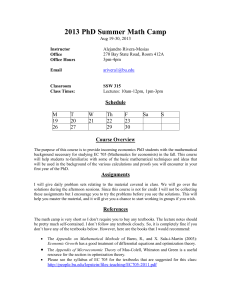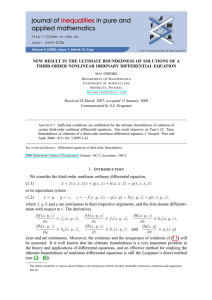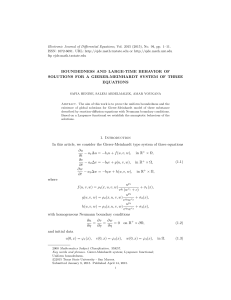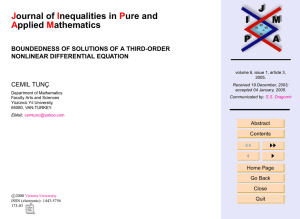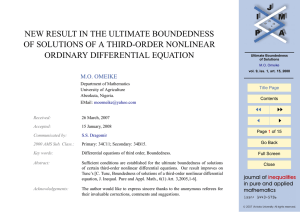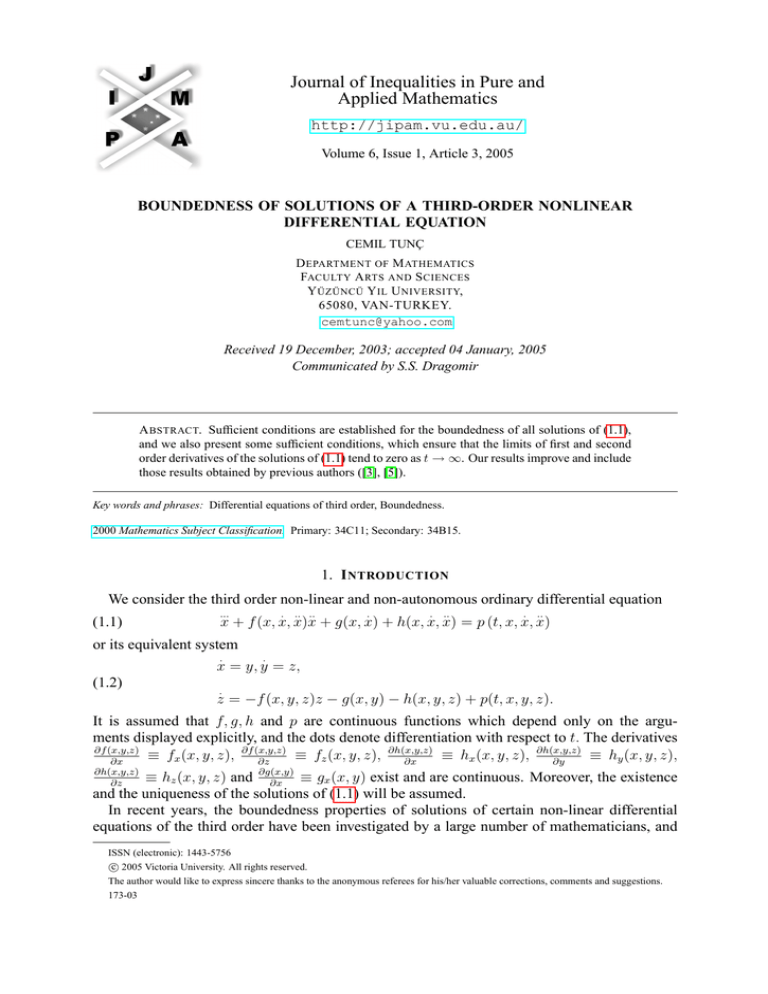
Journal of Inequalities in Pure and
Applied Mathematics
http://jipam.vu.edu.au/
Volume 6, Issue 1, Article 3, 2005
BOUNDEDNESS OF SOLUTIONS OF A THIRD-ORDER NONLINEAR
DIFFERENTIAL EQUATION
CEMIL TUNÇ
D EPARTMENT OF M ATHEMATICS
FACULTY A RTS AND S CIENCES
Y ÜZÜNCÜ Y IL U NIVERSITY,
65080, VAN-TURKEY.
cemtunc@yahoo.com
Received 19 December, 2003; accepted 04 January, 2005
Communicated by S.S. Dragomir
A BSTRACT. Sufficient conditions are established for the boundedness of all solutions of (1.1),
and we also present some sufficient conditions, which ensure that the limits of first and second
order derivatives of the solutions of (1.1) tend to zero as t → ∞. Our results improve and include
those results obtained by previous authors ([3], [5]).
Key words and phrases: Differential equations of third order, Boundedness.
2000 Mathematics Subject Classification. Primary: 34C11; Secondary: 34B15.
1. I NTRODUCTION
We consider the third order non-linear and non-autonomous ordinary differential equation
(1.1)
...
.
.. ..
.
.
..
.
..
x + f (x, x, x)x + g(x, x) + h(x, x, x) = p (t, x, x, x)
or its equivalent system
.
.
x = y, y = z,
(1.2)
.
z = −f (x, y, z)z − g(x, y) − h(x, y, z) + p(t, x, y, z).
It is assumed that f, g, h and p are continuous functions which depend only on the arguments displayed explicitly, and the dots denote differentiation with respect to t. The derivatives
∂f (x,y,z)
≡ fx (x, y, z), ∂f (x,y,z)
≡ fz (x, y, z), ∂h(x,y,z)
≡ hx (x, y, z), ∂h(x,y,z)
≡ hy (x, y, z),
∂x
∂z
∂x
∂y
≡ hz (x, y, z) and ∂g(x,y)
≡ gx (x, y) exist and are continuous. Moreover, the existence
∂x
and the uniqueness of the solutions of (1.1) will be assumed.
In recent years, the boundedness properties of solutions of certain non-linear differential
equations of the third order have been investigated by a large number of mathematicians, and
∂h(x,y,z)
∂z
ISSN (electronic): 1443-5756
c 2005 Victoria University. All rights reserved.
The author would like to express sincere thanks to the anonymous referees for his/her valuable corrections, comments and suggestions.
173-03
2
C EMIL T UNÇ
they have obtained many results for some special cases of the equation (1.1) with h ≡ h(x), see
. ..
([1], [4], [5], [7] – [10]) and references therein. However, in the case h ≡ h(x, x, x), the results
about third order nonlinear differential equations are relatively scarce.
In ([5], [6]), Ezeilo discussed the ultimate boundedness and the existence of the periodic
solutions of equations of the form
...
. ..
.
.
..
x + ψ(x)x + ϕ(x)x + v(x, x, x) = p(t).
Later, in a recent paper, Bereketoğlu and Györi [3] considered the differential equation described as follows
...
. ..
.
.
..
.
..
x + f (x, x)x + g(x, x) + h(x, x, x) = p(t, x, x, x),
(1.3)
and the author established sufficient conditions under which all solutions of the non-autonomous
differential equation (1.3) are bounded and the limits of first and second order derivatives of
the solutions of (1.3) tend to zero as t → ∞. In this paper, we shall be concerned with the
boundedness results of the solutions of third-order non-linear differential equations of the form
(1.1).
The motivation for the present work has come from the papers of Ezeilo ([5], [6]), Bereketoğlu and Györi [3] and the paper mentioned above. The results obtained herein are comparable
in generality to the works of Bereketoğlu and Györi [3] and Ezeilo [5], and our results also
include and improve the results in ([3], [5]). It should also be noted that the first result obtained
. ..
here is proved without using the boundedness of h(x, x, x).
2. M AIN R ESULTS
The main results of this paper are the following.
Theorem 2.1. Further to the basic assumptions on the functions f, g, h and p assume that the
following conditions are satisfied (a, b, c, l, m and A- some positive constants):
(i) f (x, y, z) ≥ a and ab − c > 0 for all x, y, z;
(ii)
(iii)
g(x,y)
y
≥ b for all x, y 6= 0;
h(x,0,0)
x
≥ c for all x 6= 0;
(iv) 0 < hx (x, y, 0) ≤ c for all x, y;
(v) hy (x, y, 0) ≥ 0 for all x, y;
(vi) hz (x, y, 0) ≥ m for all x, y;
(vii) yfx (x, y, z) ≤ 0,
yfz (x, y, z) ≥ 0 and gx (x, y) ≤ 0 for all x, y, z;
(viii) yzhy (x, y, 0) + ayzhz (x, y, z) ≥ 0 for all x, y, z;
Rt
(ix) |p(t, x, y, z)| ≤ e(t) for all t ≥ 0, x, y, z, where 0 e(s)ds ≤ A < ∞.
Then given any finite numbers x0 , y0 , z0 there is a finite constant D = D(x0 , y0 , z0 ) such that
the unique solution x(t) of (1.2) which is determined by the initial conditions
(2.1)
x(0) = x0 ,
y(0) = y0 ,
z(0) = z0
|x(t)| ≤ D,
|y(t)| ≤ D,
|z(t)| ≤ D
satisfies
for all t ≥ 0.
J. Inequal. Pure and Appl. Math., 6(1) Art. 3, 2005
http://jipam.vu.edu.au/
B OUNDEDNESS OF S OLUTION OF A 3 RD -O RDER N ONLINEAR D.E.
3
Theorem 2.2. Let all the conditions of Theorem 2.1 be satisfied; in addition, we assume that
e(t) is bounded for t ≥ 0 , that is, there is a positive constant M such that |e(t)| ≤ M for all
t ≥ 0. Then every solution x(t) of (1.2) determined by the initial conditions (2.1) satisfies
.
..
x(t) → 0, x(t) → 0 as → ∞.
Remark 2.3. Theorem 2.1 and Theorem 2.2 contain far less restrictive conditions than those
established in Bereketoğlu and Györi [3, Theorem 1, Theorem 2]. Because the result established
in [3] can be proved here without the assumptions hy (x, y, 0) ≥ 14 > 0 and ab + al4 > a2 m + c.
Remark 2.4. It should be noted that the function h satisfying conditions (iii)-(vi) essentially
reduces to something like h(x, y, z) = cx + h0 (x, z). For example, the function h(x, y, z) :=
cx + z(x2 + m) satisfies the above conditions.
The proofs of Theorem 2.1 and Theorem 2.2 depend on some certain fundamental properties
of a continuously differentiable Lyapunov function V = V (x, y, z) defined by:
Z x
(2.2)
V (x, y, z) = a
h(ξ, 0, 0)dξ + h(x, 0, 0)y
0
Z y
Z y
1
+
g(x, η)dη + a
f (x, η, 0)ηdη + ayz + z 2 .
2
0
0
Namely, this function and its time derivative satisfy some fundamental inequalities.
In the subsequent discussion we require the following lemmas.
Lemma 2.5. Subject to the assumptions (i)-(vi) of Theorem 2.1, V (0, 0, 0) = 0 and there is a
positive constant K depending only on a, b and c such that
(2.3)
V (x, y, z) ≥ K(x2 + y 2 + z 2 )
for all x, y, z.
≥ b (y 6= 0) and f (x, y, z) ≥
Proof. It is clear that V (0, 0, 0) = 0. Since hx (x, y, z) ≤ c, g(x,y)
y
a, the function V (x, y, z) can be rearranged as follows (for y 6= 0):
Z x
b
1
1
(2.4) V (x, y, z) ≥ a
h(ξ, 0, 0)dξ + h(x, 0, 0)y + y 2 + a2 y 2 + ayz + z 2
2
2
2
0
1
1
=
[by + h(x, 0, 0)]2 + [ay + z]2
2b
Z x 2
Z y
1
+
4
h(ξ, 0, 0)
(ab − hξ (ξ, 0, 0))ηdη dξ
2by 2
0
0
1
1
≥
[by + h(x, 0, 0)]2 + [ay + z]2
2b
Z x 2
Z y
1
+
4
h(ξ, 0, 0)
(ab − c)ηdη dξ , (for y 6= 0) .
2by 2
0
0
Now, it is obvious from (2.4) that the function V (x, y, z) defined in (2.2) is a positive definite
function which has infinite inferior limit and infinitesimal upper limit. Hence, there is a positive
constant K such that
V (x, y, z) ≥ K(x2 + y 2 + z 2 ).
The proof of this lemma is now complete.
J. Inequal. Pure and Appl. Math., 6(1) Art. 3, 2005
http://jipam.vu.edu.au/
4
C EMIL T UNÇ
Lemma 2.6. Under the assumptions of Theorem 2.1, there are positive constants D1 and D2
depending only on a and m such that, if (x(t), y(t), z(t)) is any solution of (1.2), then
d
V (x(t), y(t), z(t)) ≤ −D1 (y 2 + z 2 ) + D2 (|y| + |z|)e(t).
dt
Proof. An easy calculation from (2.2) and (1.2) yields that
Z y
Z y
.
2
(2.6) V = y hx (x, 0, 0) + y
gx (x, η)dη + ay
fx (x, η, 0)ηdη
.
V =
(2.5)
0
2
0
2
+ az − f (x, y, z)z − ayg(x, y) − W1 − W2 − W3 + (ay + z)p(t, x, y, z),
where
W1 = af (x, y, z)yz − af (x, y, 0)yz,
W2 = −h(x, 0, 0)z + h(x, y, z)z,
W3 = −ayh(x, 0, 0) + ayh(x, y, z).
By (vii), we get
Z
y
Z
gx (x, η)dη ≤ 0,
y
y
fx (x, η, 0)ηdη ≤ 0.
y
0
0
It also follows from (vii), for z 6= 0, that
2 f (x, y, z) − f (x, y, 0)
= yz 2 fz (x, y, θ1 z) ≥ 0,
W1 = ayz
z
0 ≤ θ1 ≤ 1,
but W1 = 0 when z = 0. Hence
W1 ≥ 0 for all x, y, z.
Similarly, it is clear that
W2 = yzhy (x, θ2 y, 0) + z 2 hz (x, y, θ3 z) , 0 ≤ θ2 ≤ 1,
W3 = ay 2 hy (x, θ4 y, 0) + ayzhz (x, y, θ5 z),
0 ≤ θ4 ≤ 1,
0 ≤ θ3 ≤ 1
0 ≤ θ5 ≤ 1.
Then, combining the estimates for W1 , W2 , W3 with (2.6) we obtain
.
V ≤ y 2 hx (x, 0, 0) − yzhy (x, θ2 y, 0) − z 2 hz (x, y, θ3 z) − ay 2 hy (x, θ4 y, 0)
− ayzhz (x, y, θ5 z) + az 2 − f (x, y, z)z 2 − ayg(x, y) + (ay + z)p(t, x, y, z).
The assumption (viii) shows that
.
(2.7) V ≤ −ay 2 hy (x, θ4 y, 0) + y 2 hx (x, 0, 0) − z 2 hz (x, y, θ3 z)
+ az 2 − f (x, y, z)z 2 − ayg(x, y) + (ay + z)p(t, x, y, z).
Also under the assumptions of the theorem we have
−ay 2 hy (x, θ4 y, 0) ≤ 0 for all x, y;
y 2 hx (x, 0, 0) ≤ cy 2
for all x, y;
−z 2 hz (x, y, θ3 z) ≤ −mz 2
2
−f (x, y, z)z ≤ −az
2
−ayg(x, y) ≤ −aby
J. Inequal. Pure and Appl. Math., 6(1) Art. 3, 2005
2
for all x, y, z;
for all x, y, z;
for all x, y;
http://jipam.vu.edu.au/
B OUNDEDNESS OF S OLUTION OF A 3 RD -O RDER N ONLINEAR D.E.
5
(ay + z)p(t, x, y, z) ≤ |ay + z| |p(t, x, y, z)|
≤ (a |y| + |z|)e(t)
≤ max {a, 1} (|y| + |z|)e(t).
Now, let D1 = min {ab − c, m} and D2 = max {a, 1} .
From the estimates just stated above and (2.7) we obtain
.
V ≤ −(ab − c)y 2 − mz 2 + max {a, 1} (|y| + |z|)e(t)
≤ −D1 (y 2 + z 2 ) + D2 (|y| + |z|)e(t).
This completes the proof of the lemma.
Lemma 2.7. Let f be a non-negative function defined on [0, ∞) such that f is integrable on
[0, ∞) and uniformly continuous on [0, ∞). Then
lim f (t) = 0.
t→∞
Proof. See ([2]).
3. P ROOF OF T HEOREMS
Proof of Theorem 2.1. Consider the Lyapunov function V (x, y, z) defined by (2.2). By Lemma
2.5, it is obvious that
V (x, y, z) = 0,
at x2 + y 2 + z 2 = 0,
V (x, y, z) > 0,
if x2 + y 2 + z 2 6= 0,
V (x, y, z) → ∞,
as x2 + y 2 + z 2 → ∞.
Next suppose (x(t), y(t), z(t)) is any solution of (1.2) which satisfies the initial conditions
x(0) = x0 , y(0) = y0 , z(0) = z0 .
Set
V (t) ≡ V (x(t), y(t), z(t)).
Then just as in Lemma 2.6,
.
V ≤ −D1 (y 2 + z 2 ) + D2 (|y| + |z|)e(t),
so that
.
V ≤ D2 (|y| + |z|)e(t).
It follows from the obvious inequalities
|y| < 1 + y 2 ,
and
y2 + z2 ≤
|z| < 1 + z 2
1
V (x, y, z)
K
that
.
V (t) ≤ D2 (2 + y 2 + z 2 )e(t)
D2
≤
e(t)V (t) + 2D2 e(t).
K
Integrating both sides of this inequality between 0 and t (t ≥ 0) and using Gronwall-ReidBellman inequality, we obtain
Z t
1
V (t) ≤
V (0) + 2D2
χ(s)e(s)ds ,
χ(t)
0
J. Inequal. Pure and Appl. Math., 6(1) Art. 3, 2005
http://jipam.vu.edu.au/
6
C EMIL T UNÇ
where
D2
χ(t) = exp −
K
Since χ(t) ≤ 1, and using (ix) we have
Z
t
e(s)ds .
0
V (t) ≤ (V (0) + 2D2 A) exp
D2
A
K
for t ≥ 0.
As V (0) = V (x0 , y0 , z0 ), this completes the proof.
Proof of Theorem 2.2. The proof of this theorem is similar to that of Bereketoğlu and Györi [3,
Theorem 2] and hence it is omitted.
R EFERENCES
...
..
.
[1] J. ANDRES, Boundedness results of solutions to the equation x + ax + g(x)x + h(x) = p(t)
without the hypothesis h(x)sgnx ≥ 0 for |x| > R, Atti. Accad. Naz. Lincei Rend. Cl. Sci. Fis. Mat.
Natur., 80(8) (1986), 533–539.
[2] I. BARBALAT, Systeme d’equations differentielles d’oscillations non lineaires, Rev. Math. Pures
Appl., 4 (1959), 267–270.
[3] H. BEREKETOĞLU AND I. GYÖRI,On the boundedness of the solutions of a third -order nonlinear differential equation, Dynam. Systems Appl., 6(2) (1997), 263–270.
[4] E.N. CHUKWU, On boundedness of solutions of third order differential equations, Ann. Mat. Pur.
Appl., 104(4) (1975), 123–149.
[5] J.O.C. EZEILO, A generalization of a theorem of Reissig for a certain third order different equation,
Ann. Mat. Pura. Appl., 87(4) (1970), 349–356.
...
. ..
[6] J.O.C. EZEILO, A furthet result on the existence of periodic solutions of the equation x + ψ(x)x +
.
. ..
ϕ(x)x + v(x, x, x) = p(t) with a bound v, Atti. Accad. Naz. Lincei Rend. Cl. Sci. Fis. Mat. Natur.,
55 (1978), 51–57.
[7] T. HARA, On the uniform ultimate boundedness of the solutions of certain third order differential
equations, J. Math. Anal. Appl., 80(2) (1981), 533–544.
[8] M. HARROW, Further results for the solution of certain third order differential equations, J. London
Math. Soc., 43 (1968), 587–592.
[9] R. REISSIG, G. SANSONE AND R. CONTI, Nonlinear Differential Equations of Higher Order,
Noordhoff, Groningen, 1974.
[10] K.E. SWICK, Boundedness and stability for a nonlinear third order differential equation, Atti. Accad. Naz. Lincei Rend. Cl. Sci. Fis. Mat. Natur., 56(6) (1974), 859–865.
J. Inequal. Pure and Appl. Math., 6(1) Art. 3, 2005
http://jipam.vu.edu.au/







